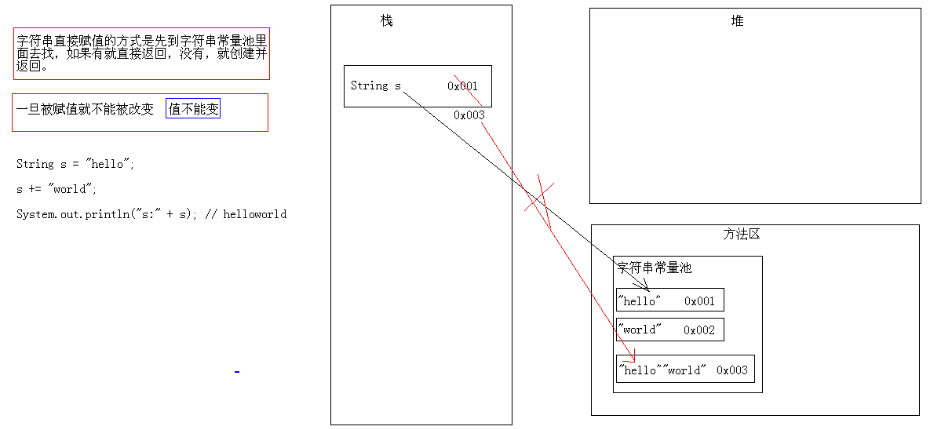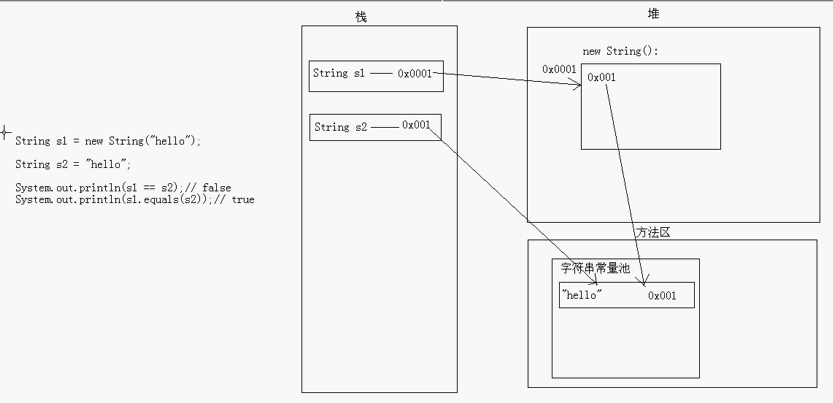您好,登錄后才能下訂單哦!
您好,登錄后才能下訂單哦!
本文實例講述了java String類功能、原理與應用。分享給大家供大家參考,具體如下:
String構造方法
package cn.itcast_01;
/*
* 字符串:就是由多個字符組成的一串數據。也可以看成是一個字符數組。
* 通過查看API,我們可以知道
* A:字符串字面值"abc"也可以看成是一個字符串對象。
* B:字符串是常量,一旦被賦值,就不能被改變。
*
* 構造方法:
* public String():空構造
* public String(byte[] bytes):把字節數組轉成字符串
* public String(byte[] bytes,int index,int length):把字節數組的一部分轉成字符串
* public String(char[] value):把字符數組轉成字符串
* public String(char[] value,int index,int count):把字符數組的一部分轉成字符串
* public String(String original):把字符串常量值轉成字符串
*
* 字符串的方法:
* public int length():返回此字符串的長度。
*/
public class StringDemo {
public static void main(String[] args) {
// public String():空構造
String s1 = new String();
System.out.println("s1:" + s1);
System.out.println("s1.length():" + s1.length());
System.out.println("--------------------------");
//s1:
//s1.length():0
// public String(byte[] bytes):把字節數組轉成字符串
byte[] bys = { 97, 98, 99, 100, 101 };
String s2 = new String(bys);
System.out.println("s2:" + s2);//abcde
System.out.println("s2.length():" + s2.length());//
System.out.println("--------------------------");
// public String(byte[] bytes,int index,int length):把字節數組的一部分轉成字符串
// 我想得到字符串"bcd"
String s3 = new String(bys, 1, 3);
System.out.println("s3:" + s3);
System.out.println("s3.length():" + s3.length());
System.out.println("--------------------------");
// public String(char[] value):把字符數組轉成字符串
char[] chs = { 'a', 'b', 'c', 'd', 'e', '愛', '林', '親' };
String s4 = new String(chs);
System.out.println("s4:" + s4);
System.out.println("s4.length():" + s4.length());
System.out.println("--------------------------");
// public String(char[] value,int index,int count):把字符數組的一部分轉成字符串
String s5 = new String(chs, 2, 4);
System.out.println("s5:" + s5);
System.out.println("s5.length():" + s5.length());
System.out.println("--------------------------");
//public String(String original):把字符串常量值轉成字符串
String s6 = new String("abcde");
System.out.println("s6:" + s6);
System.out.println("s6.length():" + s6.length());
System.out.println("--------------------------");
//字符串字面值"abc"也可以看成是一個字符串對象。
String s7 = "abcde";
System.out.println("s7:"+s7);
System.out.println("s7.length():"+s7.length());
}
}
字符串的特點:一旦被賦值,就不能改變。
但是引用可以改變
package cn.itcast_02;
/*
* 字符串的特點:一旦被賦值,就不能改變。
*/
public class StringDemo {
public static void main(String[] args) {
String s = "hello";
s += "world";
System.out.println("s:" + s); // helloworld
}
}
圖解:

String s = new String("hello")和 String s = "hello";的區別?
String字面值對象和構造方法創建對象的區別
package cn.itcast_02;
/*
* String s = new String("hello")和String s = "hello";的區別?
* 有。前者會創建2個對象,后者創建1個對象。
*
* ==:比較引用類型比較的是地址值是否相同
* equals:比較引用類型默認也是比較地址值是否相同,而String類重寫了equals()方法,比較的是內容是否相同。
*/
public class StringDemo2 {
public static void main(String[] args) {
String s1 = new String("hello");
String s2 = "hello";
System.out.println(s1 == s2);// false
System.out.println(s1.equals(s2));// true
}
}
圖解:

String s5 = "hello"; String s6 = "hello"; System.out.println(s5 == s6);// 字符串字面量,直接從內存找,所以true System.out.println(s5.equals(s6));// true
package cn.itcast_02;
/*
* 看程序寫結果
* 字符串如果是變量相加,先開空間,在拼接。
* 字符串如果是常量相加,是先加,然后在常量池找,如果有就直接返回,否則,就創建。
*/
public class StringDemo4 {
public static void main(String[] args) {
String s1 = "hello";
String s2 = "world";
String s3 = "helloworld";
System.out.println(s3 == s1 + s2);// false。字符串如果是變量相加,先開空間,再拼接。
System.out.println(s3.equals((s1 + s2)));// true
System.out.println(s3 == "hello" + "world");//true。字符串如果是常量相加,是先加,然后在常量池找,如果有就直接返回,否則,就創建。
System.out.println(s3.equals("hello" + "world"));// true
// 通過反編譯看源碼,我們知道這里已經做好了處理。
// System.out.println(s3 == "helloworld");
// System.out.println(s3.equals("helloworld"));
}
}
String類的判斷功能:
package cn.itcast_03;
/*
* String類的判斷功能:
* boolean equals(Object obj):比較字符串的內容是否相同,區分大小寫
* boolean equalsIgnoreCase(String str):比較字符串的內容是否相同,忽略大小寫
* boolean contains(String str):判斷大字符串中是否包含小字符串
* boolean startsWith(String str):判斷字符串是否以某個指定的字符串開頭
* boolean endsWith(String str):判斷字符串是否以某個指定的字符串結尾
* boolean isEmpty():判斷字符串是否為空。
*
* 注意:
* 字符串內容為空和字符串對象為空。
* String s = "";//對象存在,所以可以調方法
* String s = null;//對象不存在,不能調方法
*/
public class StringDemo {
public static void main(String[] args) {
// 創建字符串對象
String s1 = "helloworld";
String s2 = "helloworld";
String s3 = "HelloWorld";
// boolean equals(Object obj):比較字符串的內容是否相同,區分大小寫
System.out.println("equals:" + s1.equals(s2));
System.out.println("equals:" + s1.equals(s3));
System.out.println("-----------------------");
// boolean equalsIgnoreCase(String str):比較字符串的內容是否相同,忽略大小寫
System.out.println("equals:" + s1.equalsIgnoreCase(s2));
System.out.println("equals:" + s1.equalsIgnoreCase(s3));
System.out.println("-----------------------");
// boolean contains(String str):判斷大字符串中是否包含小字符串
System.out.println("contains:" + s1.contains("hello"));
System.out.println("contains:" + s1.contains("hw"));
System.out.println("-----------------------");
// boolean startsWith(String str):判斷字符串是否以某個指定的字符串開頭
System.out.println("startsWith:" + s1.startsWith("h"));
System.out.println("startsWith:" + s1.startsWith("hello"));
System.out.println("startsWith:" + s1.startsWith("world"));
System.out.println("-----------------------");
// 練習:boolean endsWith(String str):判斷字符串是否以某個指定的字符串結尾這個自己玩
// boolean isEmpty():判斷字符串是否為空。
System.out.println("isEmpty:" + s1.isEmpty());
String s4 = "";
String s5 = null;
System.out.println("isEmpty:" + s4.isEmpty());
// NullPointerException
// s5對象都不存在,所以不能調用方法,空指針異常
// System.out.println("isEmpty:" + s5.isEmpty());
}
}
String類的判斷功能---使用---鍵盤錄入猜字小游戲
package cn.itcast_03;
import java.util.Scanner;
/*
* 模擬登錄,給三次機會,并提示還有幾次。如果登錄成功,就可以玩猜數字小游戲了。
*
* 分析:
* A:定義用戶名和密碼。已存在的。
* B:鍵盤錄入用戶名和密碼。
* C:比較用戶名和密碼。
* 如果都相同,則登錄成功
* 如果有一個不同,則登錄失敗
* D:給三次機會,用循環改進,最好用for循環。
*/
public class StringTest2 {
public static void main(String[] args) {
// 定義用戶名和密碼。已存在的。
String username = "admin";
String password = "admin";
// 給三次機會,用循環改進,最好用for循環。
for (int x = 0; x < 3; x++) {
// x=0,1,2
// 鍵盤錄入用戶名和密碼。
Scanner sc = new Scanner(System.in);
System.out.println("請輸入用戶名:");
String name = sc.nextLine();
System.out.println("請輸入密碼:");
String pwd = sc.nextLine();
// 比較用戶名和密碼。
if (name.equals(username) && pwd.equals(password)) {
// 如果都相同,則登錄成功
System.out.println("登錄成功,開始玩游戲");
//猜數字游戲
GuessNumberGame.start();
break;
} else {
// 如果有一個不同,則登錄失敗
// 2,1,0
// 如果是第0次,應該換一種提示
if ((2 - x) == 0) {
System.out.println("帳號被鎖定,請與班長聯系");
} else {
System.out.println("登錄失敗,你還有" + (2 - x) + "次機會");
}
}
}
}
}
package cn.itcast_03;
import java.util.Scanner;
/*
* 這時猜數字小游戲的代碼
*/
public class GuessNumberGame {
private GuessNumberGame() {
}
public static void start() {
// 產生一個隨機數
int number = (int) (Math.random() * 100) + 1;
while (true) {
// 鍵盤錄入數據
Scanner sc = new Scanner(System.in);
System.out.println("請輸入你要猜的數據(1-100):");
int guessNumber = sc.nextInt();
// 判斷
if (guessNumber > number) {
System.out.println("你猜的數據" + guessNumber + "大了");
} else if (guessNumber < number) {
System.out.println("你猜的數據" + guessNumber + "小了");
} else {
System.out.println("恭喜你,猜中了");
break;
}
}
}
}
String類的獲取功能
package cn.itcast_04;
/*
* String類的獲取功能
* int length():獲取字符串的長度。
* char charAt(int index):獲取指定索引位置的字符
* int indexOf(int ch):返回指定字符在此字符串中第一次出現處的索引。
* 為什么這里是int類型,而不是char類型?
* 原因是:'a'和97其實都可以代表'a'。如果里面寫char,就不能寫數字97了
* int indexOf(String str):返回指定字符串在此字符串中第一次出現處的索引。
* int indexOf(int ch,int fromIndex):返回指定字符在此字符串中從指定位置后第一次出現處的索引。
* int indexOf(String str,int fromIndex):返回指定字符串在此字符串中從指定位置后第一次出現處的索引。
* String substring(int start):從指定位置開始截取字符串,默認到末尾。
* String substring(int start,int end):從指定位置開始到指定位置結束截取字符串。
*/
public class StringDemo {
public static void main(String[] args) {
// 定義一個字符串對象
String s = "helloworld";
// int length():獲取字符串的長度。
System.out.println("s.length:" + s.length());//10
System.out.println("----------------------");
// char charAt(int index):獲取指定索引位置的字符
System.out.println("charAt:" + s.charAt(7));//
System.out.println("----------------------");
// int indexOf(int ch):返回指定字符在此字符串中第一次出現處的索引。
System.out.println("indexOf:" + s.indexOf('l'));
System.out.println("----------------------");
// int indexOf(String str):返回指定字符串在此字符串中第一次出現處的索引。
System.out.println("indexOf:" + s.indexOf("owo"));
System.out.println("----------------------");
// int indexOf(int ch,int fromIndex):返回指定字符在此字符串中從指定位置后第一次出現處的索引。
System.out.println("indexOf:" + s.indexOf('l', 4));
System.out.println("indexOf:" + s.indexOf('k', 4)); // -1
System.out.println("indexOf:" + s.indexOf('l', 40)); // -1
System.out.println("----------------------");
// 自己練習:int indexOf(String str,int
// fromIndex):返回指定字符串在此字符串中從指定位置后第一次出現處的索引。
// String substring(int start):從指定位置開始截取字符串,默認到末尾。包含start這個索引
System.out.println("substring:" + s.substring(5));
System.out.println("substring:" + s.substring(0));
System.out.println("----------------------");
// String substring(int start,intend):從指定位置開始到指定位置結束截取字符串。
//包括start索引但是不包end索引
System.out.println("substring:" + s.substring(3, 8));
System.out.println("substring:" + s.substring(0, s.length()));
}
}
字符串遍歷:
package cn.itcast_04;
/*
* 需求:遍歷獲取字符串中的每一個字符
*
* 分析:
* A:如何能夠拿到每一個字符呢?
* char charAt(int index)
* B:我怎么知道字符到底有多少個呢?
* int length()
*/
public class StringTest {
public static void main(String[] args) {
// 定義字符串
String s = "helloworld";
for (int x = 0; x < s.length(); x++) {
System.out.println(s.charAt(x));
}
}
}
統計大寫字母,小寫字母,數字在字符串中的個數
package cn.itcast_04;
/*
* 需求:統計一個字符串中大寫字母字符,小寫字母字符,數字字符出現的次數。(不考慮其他字符)
* 舉例:
* "Hello123World"
* 結果:
* 大寫字符:2個
* 小寫字符:8個
* 數字字符:3個
*
* 分析:
* 前提:字符串要存在
* A:定義三個統計變量
* bigCount=0
* smallCount=0
* numberCount=0
* B:遍歷字符串,得到每一個字符。
* length()和charAt()結合
* C:判斷該字符到底是屬于那種類型的
* 大:bigCount++
* 小:smallCount++
* 數字:numberCount++
*
* 這道題目的難點就是如何判斷某個字符是大的,還是小的,還是數字的。
* ASCII碼表:
* 0 48
* A 65
* a 97
* 雖然,我們按照數字的這種比較是可以的,但是想多了,有比這還簡單的
* char ch = s.charAt(x);
*
* if(ch>='0' && ch<='9') numberCount++
* if(ch>='a' && ch<='z') smallCount++
* if(ch>='A' && ch<='Z') bigCount++
* D:輸出結果。
*
* 練習:把給定字符串的方式,改進為鍵盤錄入字符串的方式。
*/
public class StringTest2 {
public static void main(String[] args) {
//定義一個字符串
String s = "Hello123World";
//定義三個統計變量
int bigCount = 0;
int smallCount = 0;
int numberCount = 0;
//遍歷字符串,得到每一個字符。
for(int x=0; x<s.length(); x++){
char ch = s.charAt(x);
//判斷該字符到底是屬于那種類型的,char類型會轉成int類型
if(ch>='a' && ch<='z'){
smallCount++;
}else if(ch>='A' && ch<='Z'){
bigCount++;
}else if(ch>='0' && ch<='9'){
numberCount++;
}
}
//輸出結果。
System.out.println("大寫字母"+bigCount+"個");
System.out.println("小寫字母"+smallCount+"個");
System.out.println("數字"+numberCount+"個");
}
}
String的轉換功能:
package cn.itcast_05;
/*
* String的轉換功能:
* byte[] getBytes():把字符串轉換為字節數組。
* char[] toCharArray():把字符串轉換為字符數組。
* static String valueOf(char[] chs):把字符數組轉成字符串。
* static String valueOf(int i):把int類型的數據轉成字符串。
* 注意:String類的valueOf方法可以把任意類型的數據轉成字符串。
* String toLowerCase():把字符串轉成小寫。
* String toUpperCase():把字符串轉成大寫。
* String concat(String str):把字符串拼接。
*/
public class StringDemo {
public static void main(String[] args) {
// 定義一個字符串對象
String s = "JavaSE";
// byte[] getBytes():把字符串轉換為字節數組。
byte[] bys = s.getBytes();
for (int x = 0; x < bys.length; x++) {
System.out.println(bys[x]);
}
System.out.println("----------------");
// char[] toCharArray():把字符串轉換為字符數組。
char[] chs = s.toCharArray();
for (int x = 0; x < chs.length; x++) {
System.out.println(chs[x]);
}
System.out.println("----------------");
// static String valueOf(char[] chs):把字符數組轉成字符串。
String ss = String.valueOf(chs);
System.out.println(ss);
System.out.println("----------------");
// static String valueOf(int i):把int類型的數據轉成字符串。
int i = 100;
String sss = String.valueOf(i);
System.out.println(sss);
System.out.println("----------------");
// String toLowerCase():把字符串轉成小寫。
System.out.println("toLowerCase:" + s.toLowerCase());
System.out.println("s:" + s);
// System.out.println("----------------");
// String toUpperCase():把字符串轉成大寫。
System.out.println("toUpperCase:" + s.toUpperCase());
System.out.println("----------------");
// String concat(String str):把字符串拼接。
String s1 = "hello";
String s2 = "world";
String s3 = s1 + s2;
String s4 = s1.concat(s2);
System.out.println("s3:"+s3);
System.out.println("s4:"+s4);
}
}
把一個字符串的首字母轉成大寫,其余為小寫。(只考慮英文大小寫字母字符)
package cn.itcast_05;
/*
* 需求:把一個字符串的首字母轉成大寫,其余為小寫。(只考慮英文大小寫字母字符)
* 舉例:
* helloWORLD
* 結果:
* Helloworld
*
* 分析:
* A:先獲取第一個字符
* B:獲取除了第一個字符以外的字符
* C:把A轉成大寫
* D:把B轉成小寫
* E:C拼接D
*/
public class StringTest {
public static void main(String[] args) {
// 定義一個字符串
String s = "helloWORLD";
// 先獲取第一個字符
String s1 = s.substring(0, 1);
// 獲取除了第一個字符以外的字符
String s2 = s.substring(1);
// 把A轉成大寫
String s3 = s1.toUpperCase();
// 把B轉成小寫
String s4 = s2.toLowerCase();
// C拼接D
String s5 = s3.concat(s4);
System.out.println(s5);
// 優化后的代碼
// 鏈式編程
String result = s.substring(0, 1).toUpperCase()
.concat(s.substring(1).toLowerCase());
System.out.println(result);
}
}
String類的其他功能:
package cn.itcast_06;
/*
* String類的其他功能:
*
* 替換功能:
* String replace(char old,char new)
* String replace(String old,String new)
*
* 去除字符串兩空格
* String trim()
*
* 按字典順序比較兩個字符串
* int compareTo(String str)
* int compareToIgnoreCase(String str)
*/
public class StringDemo {
public static void main(String[] args) {
// 替換功能
String s1 = "helloworld";
String s2 = s1.replace('l', 'k');
String s3 = s1.replace("owo", "ak47");
System.out.println("s1:" + s1);
System.out.println("s2:" + s2);
System.out.println("s3:" + s3);
System.out.println("---------------");
// 去除字符串兩空格
String s4 = " hello world ";
String s5 = s4.trim();
System.out.println("s4:" + s4 + "---");
System.out.println("s5:" + s5 + "---");
// 按字典順序比較兩個字符串
String s6 = "hello";
String s7 = "hello";
String s8 = "abc";
String s9 = "xyz";
System.out.println(s6.compareTo(s7));// 0
System.out.println(s6.compareTo(s8));// 7
System.out.println(s6.compareTo(s9));// -16
}
}
compareTo源碼解析
public int compareTo(String anotherString) {
//this -- s1 -- "hello"
//anotherString -- s2 -- "hel"
int len1 = value.length; //this.value.length--s1.toCharArray().length--5
int len2 = anotherString.value.length;//s2.value.length -- s2.toCharArray().length--3
int lim = Math.min(len1, len2); //Math.min(5,3); -- lim=3;
char v1[] = value; //s1.toCharArray()
char v2[] = anotherString.value;
//char v1[] = {'h','e','l','l','o'};
//char v2[] = {'h','e','l'};
int k = 0;
while (k < lim) {
char c1 = v1[k]; //c1='h','e','l'
char c2 = v2[k]; //c2='h','e','l'
if (c1 != c2) {
return c1 - c2;
}
k++;
}
return len1 - len2; //5-3=2;
}
String s1 = "hello";
String s2 = "hel";
System.out.println(s1.compareTo(s2)); // 2
把數組中的數據按照指定個格式拼接成一個字符串
package cn.itcast_07;
/*
* 需求:把數組中的數據按照指定個格式拼接成一個字符串
* 舉例:
* int[] arr = {1,2,3};
* 輸出結果:
* "[1, 2, 3]"
* 分析:
* A:定義一個字符串對象,只不過內容為空
* B:先把字符串拼接一個"["
* C:遍歷int數組,得到每一個元素
* D:先判斷該元素是否為最后一個
* 是:就直接拼接元素和"]"
* 不是:就拼接元素和逗號以及空格
* E:輸出拼接后的字符串
*
* 把代碼用功能實現。
*/
public class StringTest2 {
public static void main(String[] args) {
// 前提是數組已經存在
int[] arr = { 1, 2, 3 };
// 寫一個功能,實現結果
String result = arrayToString(arr);
System.out.println("最終結果是:" + result);
}
/*
* 兩個明確: 返回值類型:String 參數列表:int[] arr
*/
public static String arrayToString(int[] arr) {
// 定義一個字符串
String s = "";
// 先把字符串拼接一個"["
s += "[";
// 遍歷int數組,得到每一個元素
for (int x = 0; x < arr.length; x++) {
// 先判斷該元素是否為最后一個
if (x == arr.length - 1) {
// 就直接拼接元素和"]"
s += arr[x];
s += "]";
} else {
// 就拼接元素和逗號以及空格
s += arr[x];
s += ", ";
}
}
return s;
}
}
字符串反轉
package cn.itcast_07;
import java.util.Scanner;
/*
* 字符串反轉
* 舉例:鍵盤錄入"abc"
* 輸出結果:"cba"
*
* 分析:
* A:鍵盤錄入一個字符串
* B:定義一個新字符串
* C:倒著遍歷字符串,得到每一個字符
* a:length()和charAt()結合
* b:把字符串轉成字符數組
* D:用新字符串把每一個字符拼接起來
* E:輸出新串
*/
public class StringTest3 {
public static void main(String[] args) {
// 鍵盤錄入一個字符串
Scanner sc = new Scanner(System.in);
System.out.println("請輸入一個字符串:");
String line = sc.nextLine();
String s = myReverse(line);
System.out.println("實現功能后的結果是:" + s);
}
/*
* 兩個明確: 返回值類型:String 參數列表:String
*/
public static String myReverse(String s) {
// 定義一個新字符串
String result = "";
// 把字符串轉成字符數組
char[] chs = s.toCharArray();
// 倒著遍歷字符串,得到每一個字符
for (int x = chs.length - 1; x >= 0; x--) {
// 用新字符串把每一個字符拼接起來
result += chs[x];
}
return result;
}
}
統計大串中小串出現的次數
package cn.itcast_07;
/*
* 統計大串中小串出現的次數
* 舉例:
* 在字符串"woaijavawozhenaijavawozhendeaijavawozhendehenaijavaxinbuxinwoaijavagun"
* 結果:
* java出現了5次
*
* 分析:
* 前提:是已經知道了大串和小串。
*
* A:定義一個統計變量,初始化值是0
* B:先在大串中查找一次小串第一次出現的位置
* a:索引是-1,說明不存在了,就返回統計變量
* b:索引不是-1,說明存在,統計變量++
* C:把剛才的索引+小串的長度作為開始位置截取上一次的大串,返回一個新的字符串,并把該字符串的值重新賦值給大串
* D:回到B
*/
public class StringTest5 {
public static void main(String[] args) {
// 定義大串
String maxString = "woaijavawozhenaijavawozhendeaijavawozhendehenaijavaxinbuxinwoaijavagun";
// 定義小串
String minString = "java";
// 寫功能實現
int count = getCount(maxString, minString);
System.out.println("Java在大串中出現了:" + count + "次");
}
/*
* 兩個明確: 返回值類型:int 參數列表:兩個字符串
*/
public static int getCount(String maxString, String minString) {
// 定義一個統計變量,初始化值是0
int count = 0;
int index;
//先查,賦值,判斷
while((index=maxString.indexOf(minString))!=-1){
count++;
maxString = maxString.substring(index + minString.length());
}
return count;
}
}
更多關于java相關內容感興趣的讀者可查看本站專題:《Java字符與字符串操作技巧總結》、《Java數組操作技巧總結》、《Java數學運算技巧總結》、《Java數據結構與算法教程》及《Java操作DOM節點技巧總結》
希望本文所述對大家java程序設計有所幫助。
免責聲明:本站發布的內容(圖片、視頻和文字)以原創、轉載和分享為主,文章觀點不代表本網站立場,如果涉及侵權請聯系站長郵箱:is@yisu.com進行舉報,并提供相關證據,一經查實,將立刻刪除涉嫌侵權內容。